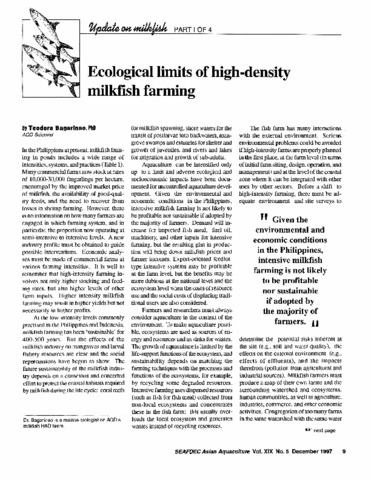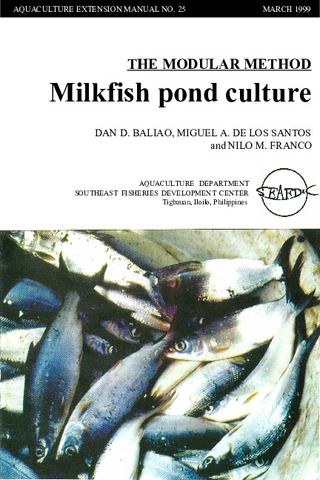Ecological limits of high-density milkfish farming
- Global styles
- MLA
- Vancouver
- Elsevier - Harvard
- APA
- Help

View/
Downloads: 1,461
Date
1997Author
Page views
3,794ASFA keyword
AGROVOC keyword
Taxonomic term
Metadata
Show full item record
Share
Abstract
In the Philippines at present, milkfish farming in ponds includes a wide range of intensities, systems and practices. To make aquaculture possible, ecosystems are used as sources of energy and resources and as sinks for wastes. The growth of aquaculture is limited by the life-support functions of the ecosystem, and sustainability depends on matching the farming techniques with the processes and functions of the ecosystems, for example, by recycling some degraded resources. The fish farm has many interactions with the external environment. Serious environmental problems may be avoided if high-intensity farms are properly planned in the first place, at the farm level and at the level of the coastal zone where it can be integrated with other uses by other sectors. It is believed that the key to immediate success in the mass production of milkfish for local consumption and for export of value-added forms may be in semi-intensive farming at target yields of 3 tons per ha per year, double the current national average. Intensive milkfish farming will be limited by environmental, resource and market constraints. Integrated intensive farming systems are the appropriate long-term response to the triple needs of the next century: more food, more income, and more jobs for more people, all from less land, less resources, and less non-renewable energy.
Suggested Citation
Bagarinao, T. (1997). Ecological limits of high-density milkfish farming. SEAFDEC Asian Aquaculture , 19(5), 9-11. http://hdl.handle.net/10862/1771
Type
magazineArticleISSN
0115-4974Collections
Related items
Showing items related by title, author, creator and subject.
-
Series: Aquaculture extension manual; No. 25
The modular method: Milkfish pond culture
Baliao, Dan D.; de los Santos, Miguel A.; Franco, Nilo M. (Aquaculture Department, Southeast Asian Fisheries Development Center, 1999)The modular method of milkfish culture (Chanos chanos) described in the manual is an improvement over the traditional extensive method. The manual is intended for the use of fish farmers and aquaculturists, extensionists, ... -
Evaluation of organic and inorganic fertilizers in brackishwater milkfish ponds
Bombeo-Tuburan, Isidra; Agbayani, Renato F.; Subosa, Precilla F. (Elsevier, 1989)The study was conducted in twelve 144-m2 ponds to evaluate the effect of different organic and inorganic fertilizers on the growth, survival, gross production, and profitability of marketable milkfish. The ... -
Milkfish breeding and hatchery technology at SEAFDEC/AQD
Unknown author (Aquaculture Department, Southeast Asian Fisheries Development Center, 1999)Describes the techniques already adopted by the private sector: broodstock management, broodstock diet, commercial fry production, live transport, and larval diet. A list of AQD research publications on milkfish is included.







